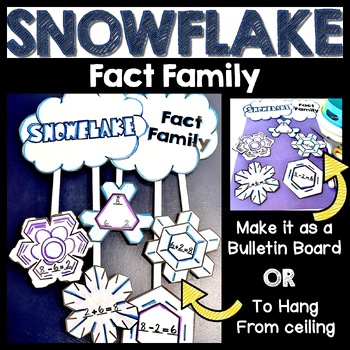Winter Bulletin Board | Fact Family Snow Craft | Math Addition Snowflakes
- PDF
Description
Snowflake Fact Family Bulletin Board | Math Activity for 1st-3rd Grade ❄️
Description: Elevate your math lessons with the Snowflake Fact Family Bulletin Board, made for 1st to 3rd-grade classrooms. This snowflake activity makes for an engaging activity for the primary grades.
What's Inside:
❄️Fact Family Snowflake
❄️ Addition Snowflakes
❄️ Subtraction Snowflakes
❄️Paper Strips for Hanging (if needed)
☁️ Clouds for Display
Early Finisher Fact Family Pages
How to Use: Guide students through independent completion of snowflake activities. Encourage students to write the largest number under the star on the triangular snowflake. Have students continue on to the addition and subtraction fact family snowflakes, trace in marker, and add a creative touch with coloring.
Display Options: Hang completed snowflakes from the ceiling using paper strips OR hole punch and hang with string/fishing line. Alternatively, create a bulletin board by gluing snowflakes onto construction paper with clouds hanging above. * See pictures above for examples.
Why Choose This Resource?
Makes a beautiful winter display in your classroom!
Ideal for 1st to 3rd-grade classrooms
⏰ Time-Saving: Minimal prep – just print and go!
Engaging Activities: I make all of my resources with the needs of primary students in mind. This craft provides engaging activities that capture and maintain their interest, making learning fact families feel like play.
Download the "Snowflake Fact Family Bulletin Board Craft" and watch as your students eye's light up at a CRAFT instead of another scripted math lesson!
I hope you love using this Snowflake Craft with your class as much as I loved creating it!!
**********************************************************************************************************
Check out these other resources!!
***********************************************************************************************************
TIPS FOR CUSTOMERS
When you leave feedback you earn points toward FREE TPT purchases! If you liked this product please come back to leave feedback!
Be sure to FOLLOW ME and be notified when new products are uploaded. New products are 50% off for the first 48 hours!
Thanks for stopping by!! - Trudy @ The Pawsitive Teacher





